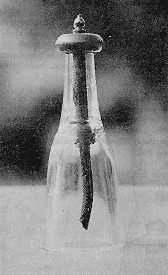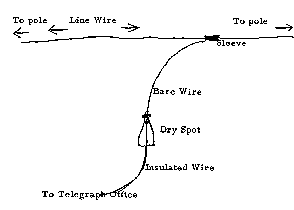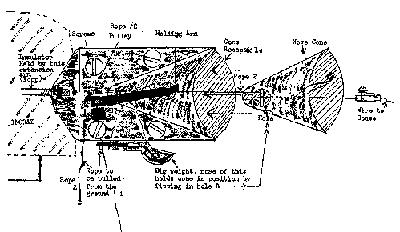Research Division
Reprinted from "INSULATORS - Crown Jewels of the Wire",, September 1970, page 24
From Gordon Smith:
The enclosed picture depicts an interesting "jewel" we have.
Will you ask your readers if anyone has them. The color is clear to light
amethyst.
These were used by Postal Telegraph Co. and were know as "dry
spots" because they created a dry spot at the end of the drop wire
insulator. The early drop wire was cloth covered and would deteriorate
when moisture got under it.
 
From Doug Vogel:
I have a couple of K.C.G.W. insulators in my collection and am wondering what
the K.C.G.W. stands for? I have thought that K.C.G.W. stood for Kansas
City Glass Works. Most of these insulators have been found in the
Midwestern part of the country. I would like to know what your readers and
you think about this.
From Gene Condon:
In "INSULATORS - Crown Jewels of the Wire", April 1970 issue, page 28, Marvin Park
asked about the CD 152 Front - Hemingray / No. 40, Back - Hemingray.
I obtained one from an antique shop last week. First I've seen in this
area (Edgefield, S.C.)
From Chris Buys:
During our trip back east this summer, my wife and I made it a point to stop
in all the back country antique stores we could find. In addition to
acquiring several new insulators for our collection (including a perfect
specimen of a threadless CD 731 S. McKee in light blue, we ran across an
interesting telephone safety device. We found it in a small town in West
Virginia.
This two piece (2" x 3") device, shown in the drawing, was
installed on insulators which connected main telephone lines with telephone
lines extending to private dwellings. Thus, during a storm, when there was
a good deal of lightning flashing around, one could separate his private line
from the main lines by simply pulling a rope (#1) which was connected to a part
of a cone receptacle on the end of his home line.

One can easily see how this was accomplished by briefly examining the
diagram. The first rope (#1), according to the gentleman who sold it to
me, hung down to the base of the telephone pole. It was tied to a small
arm of the big weight at the base of the cone receptacle. Thus, when the
rope (#1) was pulled the nose of the big weight was forced down (out of Hole A
in the nose cone) causing the nose cone (and consequently the line connected to
the house) to fall to the ground.
Rope #2, which was placed over a pulley in the cone receptacle and attached
to the front of the nose cone could be used to pull the nose come back to the
cone receptacle and thereby re-establishing contact with the main line.
It's hard to say exactly how old this device is, but is appears to be quite
crudely (although ingeniously) made. The fellow who sold it to the antique
dealer said he thought it was about fifty years old.
The antique dealer just couldn't believe I collected insulators, let alone
would want to purchase that silly contraption. He told me it had lain
there for over ten years and nobody had ever even mentioned it. It don't
think I would have, either, were it not for the insulator (common as it was)
which was attached to this interesting piece of communication equipment. I
would be very interested to hear if anyone else has seen or owns one of
these. Maybe I'm wrong on my guess as to how it was used?
| 